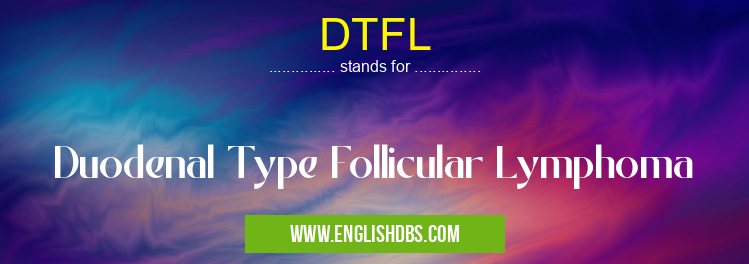What does DTFL mean in UNCLASSIFIED
DTFL is a rare subtype of non-Hodgkin lymphoma that primarily affects the duodenum, the first part of the small intestine. It is characterized by the presence of abnormal lymphoid follicles within the duodenal mucosa.

DTFL meaning in Unclassified in Miscellaneous
DTFL mostly used in an acronym Unclassified in Category Miscellaneous that means Duodenal Type Follicular Lymphoma
Shorthand: DTFL,
Full Form: Duodenal Type Follicular Lymphoma
For more information of "Duodenal Type Follicular Lymphoma", see the section below.
- DTFL stands for Duodenal Type Follicular Lymphoma.
- DTFL is a rare subtype of non-Hodgkin lymphoma that primarily involves the duodenum, the first part of the small intestine.
Characteristics of DTFL
- Primary Location: Duodenum
- Cell Type: Follicular lymphocytes
- Most Common Presenting Symptoms: Abdominal pain and gastrointestinal bleeding
- Diagnosis: Endoscopy with biopsy and immunohistochemistry
- Treatment: Surgery, chemotherapy, and/or radiation therapy
- Prognosis: The overall prognosis is favorable, with a 5-year survival rate of over 80%.
Etiology and Risk Factors
- The exact cause of DTFL is unknown.
- Potential risk factors include:
- Helicobacter pylori infection
- Immunosuppression
- Celiac disease
Differential Diagnosis
- Other types of duodenal lymphoma
- Adenocarcinoma of the duodenum
- Crohn's disease
Management and Treatment
- Treatment options depend on the stage and severity of the lymphoma.
- Surgery: May be performed to remove the affected portion of the duodenum.
- Chemotherapy: Drugs are used to kill cancer cells.
- Radiation Therapy: High-energy radiation is used to target and destroy cancer cells.
- Targeted Therapy: Drugs that target specific molecules involved in the growth and survival of cancer cells.
Essential Questions and Answers on Duodenal Type Follicular Lymphoma in "MISCELLANEOUS»UNFILED"
What is Duodenal Type Follicular Lymphoma (DTFL)?
What are the symptoms of DTFL?
Symptoms of DTFL can include abdominal pain, nausea, vomiting, weight loss, and anemia. It can also cause malabsorption, leading to nutritional deficiencies.
How is DTFL diagnosed?
DTFL is diagnosed through a biopsy of the affected duodenal tissue. The biopsy sample is examined under a microscope to detect the presence of abnormal lymphoid follicles.
What is the treatment for DTFL?
The treatment for DTFL typically involves a combination of chemotherapy and targeted therapy. Surgery may also be necessary in some cases. Treatment options are tailored to the individual patient's situation and the stage of the disease.
What is the prognosis for DTFL?
The prognosis for DTFL varies depending on the stage of the disease and the patient's overall health. With early detection and appropriate treatment, the prognosis can be favorable. However, advanced-stage DTFL can be more challenging to treat.
What are the risk factors for DTFL?
The exact risk factors for DTFL are not fully understood. However, certain factors, such as a weakened immune system and a history of celiac disease, may increase the risk of developing this condition.
Is DTFL curable?
While DTFL is not considered curable, it can be effectively managed with treatment. Treatment aims to control the growth of the lymphoma and alleviate symptoms.
Final Words:
- DTFL is a rare but treatable type of lymphoma that affects the duodenum.
- Early diagnosis and proper management are crucial for a favorable outcome.
- Patients with symptoms suggestive of DTFL should seek medical attention promptly for evaluation and appropriate treatment.
